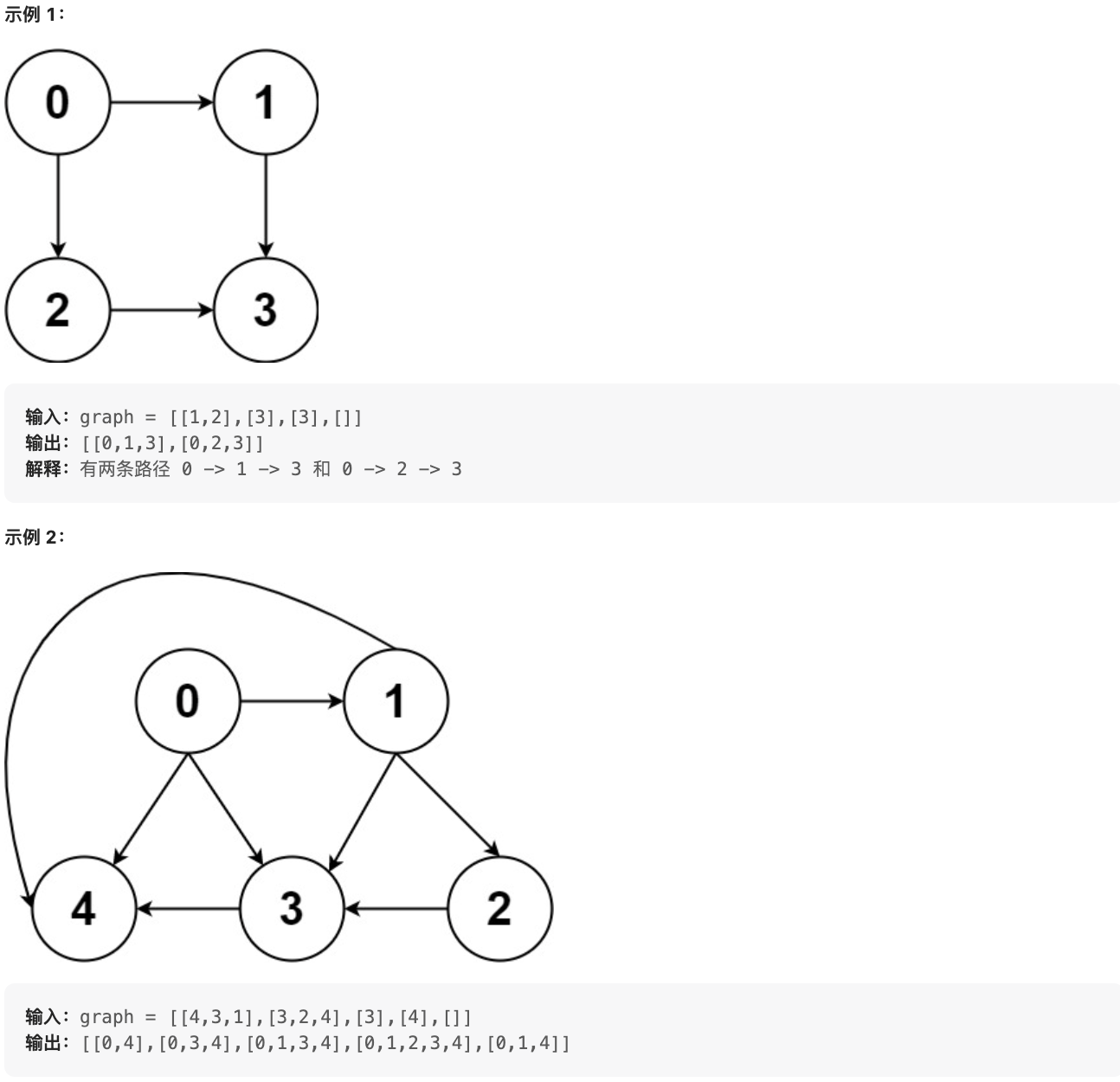深度优先搜索(dfs)理论基础
- dfs是可一个方向去搜,不到黄河不回头,直到遇到绝境了,搜不下去了,在换方向(换方向的过程就涉及到了回溯)。
- 递归和回溯是相辅相成的
void dfs(参数) {
if (终止条件) {
存放结果;
return;
}
for (选择:本节点所连接的其他节点) {
处理节点;
dfs(图,选择的节点); // 递归
回溯,撤销处理结果
}
}
797.所有可能的路径
https://leetcode.cn/problems/all-paths-from-source-to-target/
有向无环图(DAG):
有环无向图是指在图中存在至少一个环(Cycle)的无向图。环是由一系列相互连接的顶点组成的路径,其中第一个顶点和最后一个顶点相同。换句话说,从一个顶点出发,经过若干边,最终又回到了原始的顶点。
我看到题是懵的,不知道数组每个元素代表什么,后来看了答案才明白:数组中的元素相当于数组下标可以去到的地方,比如示例1,代表0可以去1和2,1可以去3,2可以去3
示例2是 :0可以去4,3,1;1可以去3,2,4;2可以去3;3可以去4,

class Solution {
private:
vector<vector<int>> result; // 收集符合条件的路径
vector<int> path; // 0节点到终点的路径
// x:目前遍历的节点
// graph:存当前的图
void dfs (vector<vector<int>>& graph, int x) {
// 要求从节点 0 到节点 n-1 的路径并输出,所以是 graph.size() - 1
if (x == graph.size() - 1) {
// 找到符合条件的一条路径
result.push_back(path);
return;
}
for (int i = 0; i < graph[x].size(); i++) {
// 遍历节点n链接的所有节点
path.push_back(graph[x][i]); // 遍历到的节点加入到路径中来
dfs(graph, graph[x][i]); // 进入下一层递归
path.pop_back(); // 回溯,撤销本节点
}
}
public:
vector<vector<int>> allPathsSourceTarget(vector<vector<int>>& graph) {
path.push_back(0); // 无论什么路径已经是从0节点出发
dfs(graph, 0); // 开始遍历
return result;
}
};
广度优先搜索BFS理论基础
- 广搜(bfs)是一圈一圈的搜索过程
- 广搜的搜索方式就适合于解决两个点之间的最短路径问题
- 我们仅仅需要一个容器,能保存我们要遍历过的元素就可以

广搜代码模板
int dir[4][2] = {
0, 1, 1, 0, -1, 0, 0, -1}; // 表示四个方向
// grid 是地图,也就是一个二维数组
// visited标记访问过的节点,不要重复访问
// x,y 表示开始搜索节点的下标
void bfs(vector<vector<char>>& grid, vector<vector<bool>>& visited, int x, int y) {
queue<pair<int, int>> que; // 定义队列
que.push({
x, y}); // 起始节点加入队列
visited[x][y] = true; // 只要加入队列,立刻标记为访问过的节点
while(!que.empty()) {
// 开始遍历队列里的元素
pair<int ,int> cur = que.front(); que.pop(); // 从队列取元素
int curx = cur.first;
int cury = cur.second; // 当前节点坐标
for (int i = 0; i < 4; i++) {
// 开始想当前节点的四个方向左右上下去遍历
int nextx = curx + dir[i][0];
int nexty = cury + dir[i][1]; // 获取周边四个方向的坐标
if (nextx < 0 || nextx >= grid.size() || nexty < 0 || nexty >= grid[0].size()) continue; // 坐标越界了,直接跳过
if (!visited[nextx][nexty]) {
// 如果节点没被访问过
que.push({
nextx, nexty}); // 队列添加该节点为下一轮要遍历的节点
visited[nextx][nexty] = true; // 只要加入队列立刻标记,避免重复访问
}
}
}
}
200. 岛屿数量
#include <vector>
#include <queue>
using namespace std;
class Solution {
int res;
int xy[4][2] = {
{
1, 0}, {
0, 1}, {
-1, 0}, {
0, -1}}; // 方向数组
void bfs(vector<vector<char>>& grid, vector<vector<bool>>& isTrue, int x, int y) {
queue<pair<int, int>> que;
que.push({
x, y});
isTrue[x][y] = true;
while (!que.empty()) {
pair<int, int> cur = que.front();
que.pop();
int curx = cur.first;
int cury = cur.second;
for (int i = 0; i < 4; i++) {
int nextx = curx + xy[i][0]; //使用新的变量来 计算下一步的x坐标
int nexty = cury + xy[i][1]; // 计算下一步的y坐标
if (nextx < 0 || nextx >= grid.size() || nexty < 0 || nexty >= grid[0].size()) continue;
if (grid[nextx][nexty] == '1' && isTrue[nextx][nexty] == false) {
que.push({
nextx, nexty});
isTrue[nextx][nexty] = true;
}
}
}
}
public:
int numIslands(vector<vector<char>>& grid) {
res = 0;
vector<vector<bool>> isTrue(grid.size(), vector<bool>(grid[0].size(), false));
for (int i = 0; i < grid.size(); i++) {
for (int j = 0; j < grid[0].size(); j++) {
if (isTrue[i][j] == false && grid[i][j] == '1') {
bfs(grid, isTrue, i, j);
res++;
}
}
}
return res;
}
};